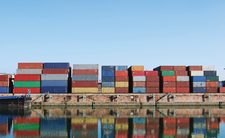Container management with Docker
Container Shipyard

© Lead Image © Ulrich Müller, 123RF.com
Docker is an economical alternative to conventional virtualization. Because each Docker container shares the underlying operating system, it enjoys the resource isolation and allocation benefits of VMs but is much more portable and efficient.
Rarely has such young software raised so much attention in such a short time as the Docker [1] container manager. Docker is one of the fastest growing open source developments in the history of free software. Released in March 2013, it made it to version 1.0 in June 2014 and was declared ready for production. In the same month, Docker was already part of Red Hat's RHEL 7 release. Further cooperative agreements exist with Canonical, openSUSE, CoreOS, VMware, IBM and others. Moreover, Docker is a member of Google's Kubernetes project [2].
The image associated with the name Docker sums it up: a ship (computer) is loaded with containers that you can stack, transport, isolate, and protect (Figure 1). Docker containers in IT are isolated virtual environments for isolated execution of processes and applications. Docker is currently used primarily for developing, testing, and deploying applications and can isolate them along with their dependencies in containers. These applications have practically no overhead and can run nearly as fast as native applications.
Unlike the well-known hypervisors [3] VirtualBox, VMware Workstation, HyperV, Parallels Desktop, or Xen, a Docker container doesn't need its own operating system. Each container uses the basic functions of its host system and is therefore self-sufficient and isolated from other containers. Only the host's kernel needs to match that of the guest.
[...]
Buy this article as PDF
(incl. VAT)
Buy Linux Magazine
Subscribe to our Linux Newsletters
Find Linux and Open Source Jobs
Subscribe to our ADMIN Newsletters
Support Our Work
Linux Magazine content is made possible with support from readers like you. Please consider contributing when you’ve found an article to be beneficial.

News
-
Two New Distros Adopt Enlightenment
MX Moksha and AV Linux 25 join ranks with Bodhi Linux and embrace the Enlightenment desktop.
-
Solus Linux 4.8 Removes Python 2
Solus Linux 4.8 has been released with the latest Linux kernel, updated desktops, and a key removal.
-
Zorin OS 18 Hits over a Million Downloads
If you doubt Linux isn't gaining popularity, you only have to look at Zorin OS's download numbers.
-
TUXEDO Computers Scraps Snapdragon X1E-Based Laptop
Due to issues with a Snapdragon CPU, TUXEDO Computers has cancelled its plans to release a laptop based on this elite hardware.
-
Debian Unleashes Debian Libre Live
Debian Libre Live keeps your machine free of proprietary software.
-
Valve Announces Pending Release of Steam Machine
Shout it to the heavens: Steam Machine, powered by Linux, is set to arrive in 2026.
-
Happy Birthday, ADMIN Magazine!
ADMIN is celebrating its 15th anniversary with issue #90.
-
Another Linux Malware Discovered
Russian hackers use Hyper-V to hide malware within Linux virtual machines.
-
TUXEDO Computers Announces a New InfinityBook
TUXEDO Computers is at it again with a new InfinityBook that will meet your professional and gaming needs.
-
SUSE Dives into the Agentic AI Pool
SUSE becomes the first open source company to adopt agentic AI with SUSE Enterprise Linux 16.

